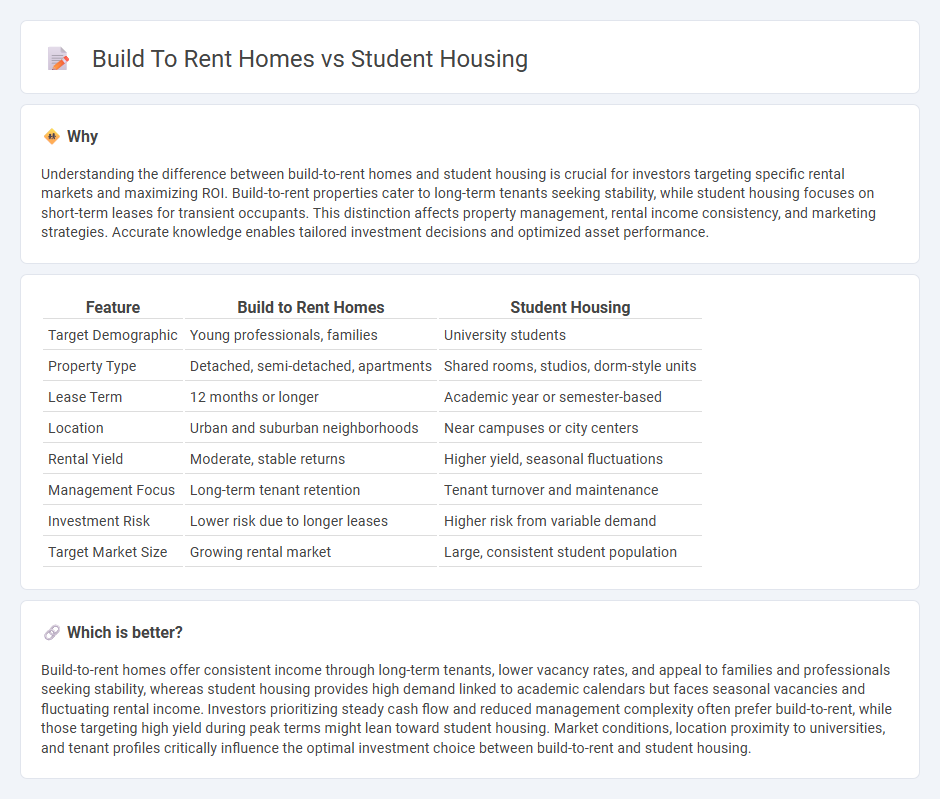
Build-to-rent homes cater to long-term residents seeking customizable living spaces with stable tenancy, while student housing focuses on short-term rentals designed for communal living and proximity to academic institutions. The build-to-rent market offers consistent rental income and lower turnover rates, contrasted by the higher demand and seasonal fluctuations seen in student housing. Explore detailed comparisons and investment insights to determine which real estate sector aligns with your portfolio goals.
Why it is important
Understanding the difference between build-to-rent homes and student housing is crucial for investors targeting specific rental markets and maximizing ROI. Build-to-rent properties cater to long-term tenants seeking stability, while student housing focuses on short-term leases for transient occupants. This distinction affects property management, rental income consistency, and marketing strategies. Accurate knowledge enables tailored investment decisions and optimized asset performance.
Comparison Table
| Feature | Build to Rent Homes | Student Housing |
|---|---|---|
| Target Demographic | Young professionals, families | University students |
| Property Type | Detached, semi-detached, apartments | Shared rooms, studios, dorm-style units |
| Lease Term | 12 months or longer | Academic year or semester-based |
| Location | Urban and suburban neighborhoods | Near campuses or city centers |
| Rental Yield | Moderate, stable returns | Higher yield, seasonal fluctuations |
| Management Focus | Long-term tenant retention | Tenant turnover and maintenance |
| Investment Risk | Lower risk due to longer leases | Higher risk from variable demand |
| Target Market Size | Growing rental market | Large, consistent student population |
Which is better?
Build-to-rent homes offer consistent income through long-term tenants, lower vacancy rates, and appeal to families and professionals seeking stability, whereas student housing provides high demand linked to academic calendars but faces seasonal vacancies and fluctuating rental income. Investors prioritizing steady cash flow and reduced management complexity often prefer build-to-rent, while those targeting high yield during peak terms might lean toward student housing. Market conditions, location proximity to universities, and tenant profiles critically influence the optimal investment choice between build-to-rent and student housing.
Connection
Build to rent homes and student housing share fundamental real estate principles focused on long-term rental income generation and market-specific tenant targeting. Both sectors require strategic location selection, efficient property management, and tailored amenities to meet the distinct needs of renters, whether families or students. Investment in these asset classes is driven by stable demand patterns, providing consistent cash flow and portfolio diversification for real estate investors.
Key Terms
Lease Structure
Student housing typically features short-term, academic-year leases designed to align with university calendars, providing flexibility for semester-based occupancy and often including utilities and furnishings in rent agreements. Build to rent homes generally offer longer, fixed-term leases with options for renewal, emphasizing stability and tailored tenant experiences with features like maintenance services and customizable lease terms. Explore detailed comparisons of lease structures to determine the best fit for tenant needs and investment goals.
Occupancy Cycle
Student housing typically experiences a cyclical occupancy pattern aligned with academic calendars, causing high demand during semesters and lower occupancy in breaks. Build-to-rent homes maintain more consistent occupancy year-round due to long-term leases targeting professionals and families. Explore the differences in occupancy dynamics and investment potential between these housing types to make informed decisions.
Tenant Demographics
Student housing primarily caters to university students aged 18-25 seeking affordable, conveniently located accommodations near campus, while build-to-rent homes attract young professionals and families looking for long-term rental stability in suburban or urban areas. Student housing features amenities such as study spaces, communal lounges, and flexible lease terms aligning with academic calendars, contrasting with the full-sized kitchens, private parking, and longer lease options typical of build-to-rent properties. Explore the distinct tenant demographics shaping these housing sectors to understand which option aligns best with your rental strategy.
Source and External Links
Student Housing at DePaul - DePaul University offers a variety of on-campus housing options, including dorms, suites, and apartments, designed to foster community and convenience for students.
Chicago, IL Student Housing & Apartments - Amber - Amber provides a wide range of off-campus student housing options in Chicago, featuring flexible leases, safety measures, and locations near major universities.
158 Rooms for rent and student housing in Chicago - June Homes - June Homes specializes in flexible, fully furnished student accommodations in Chicago, with options for both short-term and long-term stays, including support for international students.
 dowidth.com
dowidth.com